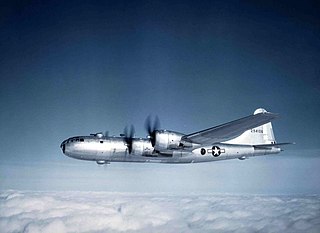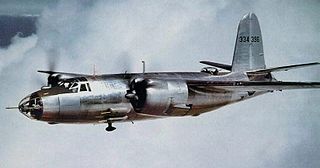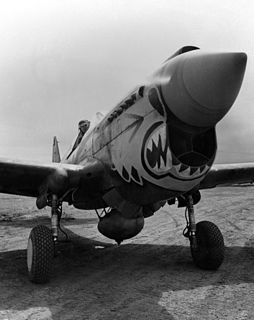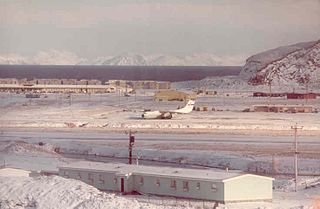The V Bomber Command is an inactive United States Army Air Forces unit. It was last assigned to Fifth Air Force, based at Irumagawa AB, Japan. It was inactivated on 31 May 1946.

The Eleventh Air Force (11 AF) is a Numbered Air Force of the United States Air Force Pacific Air Forces (PACAF). It is headquartered at Joint Base Elmendorf–Richardson, Alaska.

The 453rd Bombardment Group is an inactive United States Air Force unit that was first organized in June 1943, during World War II, as a Consolidated B-24 Liberator heavy bomber group. After training in the United States, it deployed to England in December 1943, and, starting in February 1944, participated in the strategic bombing campaign against Germany with Eighth Air Force. Its 733d Bombardment Squadron completed 82 consecutive missions without a loss, a record for Eighth Air Force bomber units. James Stewart, of film fame, was group operations officer from 31 March to 1 July 1944. The group was programmed for redeployment to the Pacific and returned to the United States in May 1945 for training, however the Japanese surrender cancelled these plans and the group was inactivated in September 1945.

The 382d Bombardment Group is a former United States Army Air Forces unit. It was last stationed at Camp Anza, California, where it was inactivated on 4 January 1946. The group was active from 1942 to 1944 as a heavy bomber training unit. It was reorganized as a very heavy bomber unit and trained for deployment overseas. However, it arrived at its overseas station too late to see combat, and returned to the United States, where it was inactivated.

The 477th Fighter Group is an Air Reserve unit of the United States Air Force. It is assigned to the Tenth Air Force, Air Force Reserve Command, stationed at Joint Base Elmendorf–Richardson, Alaska. The 477th FG is an associate unit of the 3rd Wing of Pacific Air Forces (PACAF), and if mobilized the wing is gained by PACAF.

The 470th Electronic Warfare Group is an inactive United States Air Force unit. It was last active as a crew training unit during World War II as the 470th Bombardment Group at Tonopah Army Air Field, Nevada, where it was disbanded on 31 March 1944. In 1985, the group was redesignated as an electronic warfare unit, but has not been active since then.

The 449th Expeditionary Flying Training Squadron is a provisional United States Air Force unit assigned to the 322d Air Expeditionary Group. In 2008, it was converted to an expeditionary unit on provisional status for activation by Air Combat Command any time after 28 October 2008. Its current status is undetermined.

The V Fighter Command is a disbanded United States Air Force headquarters. It was established as the 2nd Interceptor Command in June 1941, with responsibility for air defense of the northwest United States and training fighter units in its area of responsibility. Shortly after the attack on Pearl Harbor, the Army formed Western Defense Command, with responsibility for the entire Pacific coast. All air defense functions were transferred to 4th Interceptor Command, and the command was slated for transfer to the Southwest Pacific Theater as 5th Fighter Command.

The XIII Bomber Command was an inactive United States Army Air Forces formation. It was last assigned to Thirteenth Air Force, based at Clark Field, Luzon, Philippines. It was inactivated on 15 March 1946.

The VII Bomber Command is an inactive United States Air Force unit. Its last assignment was with Seventh Air Force, based on Okinawa. It was inactivated on 31 March 1946.

The VI Bomber Command was a military formation of the United States Army Air Forces. Its last assignment was with Sixth Air Force. It was based throughout its service at Albrook Field, in the Panama Canal Zone. It was inactivated on 1 November 1946.

The III Bomber Command is a disbanded United States Air Force headquarters. It was established in September 1941, shortly before the attack on Pearl Harbor to command bomber units assigned to 3rd Air Force. Following the entry of the United States into World War II, it flew patrols off the south Atlantic and Gulf coasts. However, its main efforts soon began organizing and training medium bomber units and aircrews. Its last assignment was with Third Air Force at MacDill Field, Florida. It was inactivated on 8 April 1946 and disbanded in October 1948.

The III Fighter Command is an inactive United States Air Force unit. Its last assignment was at MacDill Field, Florida. It was inactivated on 8 April 1946.

The III Tactical Air Command was a United States Army Air Forces formation. Its last assignment was with Third Air Force stationed at Barksdale Field, Louisiana. It was disbanded on 24 October 1945. The command was established in 1941 as the 3rd Air Support Command. It was responsible for training tactical units and aircrews for the Army Air Forces, except for the period from August 1943 through March 1944, when it specialized in training reconnaissance units.

The I Tactical Air Division is an inactive United States Air Force unit. It was last assigned to Second Air Force, based at Biggs Field, Texas. It was inactivated on 22 December 1945.

The IV Bomber Command is a disbanded United States Air Force headquarters. It was established in September 1941, shortly before the attack on Pearl Harbor to command bomber units assigned to 4th Air Force. Following the entry of the United States into World War II, it flew patrols off the Pacific coast. However, its main efforts soon began organizing and training bomber units and aircrews. It was disbanded at San Francisco, California on 31 March 1944.

XII Bomber Command is an inactive United States Army Air Forces formation. Its last assignment was with the Twelfth Air Force, based in Corsica, France. It was constituted on 26 February 1942, activated on 13 March 1942, and inactivated on 10 June 1944.

The XI Fighter Command was a command of the United States Army Air Forces. It was assigned to Eleventh Air Force, stationed at Adak Army Airfield, Alaska.

Naval Air Facility Adak, was a United States Navy airport located west of Adak, on Adak Island in the U.S. state of Alaska. After its closure in 1997, it was reopened as Adak Airport. The facility was designated a National Historic Landmark for its role in World War II, although most of its elements from that period have been demolished or lie in ruins.
The VIII Air Force Composite Command was a subordinate command of Eighth Air Force. It was originally responsible for combat training of aircrews arriving from the United States, a mission it continued until near the end of the war, when the air divisions began the training. Starting in late winter of 1944, the command took over special operations missions, including night leaflet dropping, infiltration of agents behind enemy lines and supplying resistance forces in occupied countries. As Allied forces advanced across Europe, most of its personnel were used to form provisional disarmament units. The command was disbanded in October 1948, when the United States Air Force decided it would have no future need for a level of command between major commands and air divisions.



















